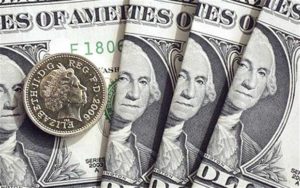 Yesterday’s trade saw GBP/USD within the range of 1.5198-1.5391. The pair closed at 1.5249, losing 0.63% on a daily basis, while marking the most considerable daily drop since September 23rd, when it depreciated 0.77%. The daily low has been the lowest level since October 6th, when the cross registered a low of 1.5137.
Yesterday’s trade saw GBP/USD within the range of 1.5198-1.5391. The pair closed at 1.5249, losing 0.63% on a daily basis, while marking the most considerable daily drop since September 23rd, when it depreciated 0.77%. The daily low has been the lowest level since October 6th, when the cross registered a low of 1.5137.
At 7:08 GMT today GBP/USD was up 0.19% for the day to trade at 1.5278. The pair touched a daily high at 1.5291 at 3:35 GMT. It is poised to test the range resistance (R3) at 1.5302.
Today the cross may be influenced by a number of macroeconomic reports as listed below.
Fundamentals
United Kingdom
Jobless Claims, ILO unemployment rate
The number of jobless claims in the United Kingdom probably dropped by 2 100 in September, according to market expectations, following an increase by 1 200 in August. At the same time, the claimant count rate, which represents the percentage change of jobless claims compared to the entire work force, probably remained steady at 2.3% for a seventh straight month in September. It has been the lowest claimant count rate in at least 8 years.
The rate of unemployment in the UK, estimated in accordance with ILO (International Labour Organization) standards, probably remained steady at 5.5% during the three months to August compared to the same period a year ago. During the three-month period to June the unemployment rate was reported at 5.6%.
During the period May-July there were 31.09 million people in employment, or an increase by 42 000 compared to the three months to April. Compared to May-July 2014, the figure represented an increase by 413 000. 22.74 million people were in full-time employment during the period May-July, or 361 000 more compared to the same period a year earlier. At the same time, 8.36 million people were in part-time employment, an increase by 52 000 compared to a year ago.
During the period May-July 1.82 million people were unemployed, or 10 000 more than during the three months to April. Compared to May-July 2014, the figure represented a decrease by 198 000.
In May to July 2015 there were 8.99 million people aged between 16 and 64, who were out of work and not seeking or available for employment, according to data by the Office for National Statistics (ONS). This represented a decrease by 24 000 compared to the three-month period to April 2015 and also a decrease by 65 000 compared to the period May-July 2014.
Average earnings including bonuses probably went up 3.1% during the three months to August compared to the same period a year ago. If so, it would be the largest annual total pay growth since early 2010.
The rate of unemployment refers to the percentage of economically active people, who are currently unemployed. According to the ILO approach, people who are considered as unemployed are either: 1) out of work, but are actively searching for employment, or 2) out of work and are waiting to be hired again during the next two weeks.
The ILO Unemployment Rate is based on a monthly survey, known as the Labour Force Survey in the United Kingdom, with approximately 40 000 individuals being interviewed every month. This indicator reflects overall economic state in the country, as there is a strong correlation between consumer spending levels and labor market conditions. Low rates of unemployment are accompanied by higher spending, which causes a favorable effect on corporate profits and also accelerates overall growth. In case the rate of unemployment met expectations or fell even further while the number of claims dropped more than projected, this would have a strong bullish effect on the sterling. The official report by the ONS is due out at 8:30 GMT.
United States
Producer prices
Annual producer prices in the United States probably fell for an eighth month in a row in September, by 0.7%, according to the median estimate by experts. If so, it would be the lowest annual drop since June. In August the annualized Producer Price Index decreased 0.8%. This index reflects the change in prices of over 8 000 products, sold by manufacturers during the respective period. The Producer Price Index (PPI) differs from the Consumer Price Index (CPI), which measures the change in prices from consumer’s perspective, due to subsidies, taxes and distribution costs of different types of manufacturers in the country. The logic behind this indicator is that in case producers are forced to pay more for goods and services, they are more likely to pass these higher costs to the end consumer. Therefore, the PPI is considered as a leading indicator of consumer inflation. In case annual producer prices fell at a lesser rate than anticipated, this would usually have a moderate bullish effect on the US dollar.
The nation’s annualized core producer price inflation, which excludes prices of volatile categories such as food and energy, probably accelerated to 1.2% in September from 0.9% in the prior month. If so, this would be the most considerable annual surge in the core PPI since January 2015, when the index rose 1.6%. The Bureau of Labor Statistics is expected to report on the official PPI performance at 12:30 GMT.
Retail sales
Retail sales in the United States probably rose 0.2% in September on a monthly basis, according to the median forecast by experts. In August sales were up another 0.2%, while the July performance was revised up to a 0.7% increase from a 0.6% gain previously.
Among the 13 major categories, 10 registered growth, while 3 showed declines. In August, the largest increases were reported for miscellaneous store retailers (0.9%), health and personal care stores (0.8%), motor vehicle and parts dealers (0.7%), food and beverages stores (0.7%), food services and drinking places (0.7%), clothing and accessories stores (0.4%) and general merchandise stores (0.4%). On the other hand, the largest decline in sales during the same month was recorded for gasoline stations and building material and garden equipment and supplies dealers (-1.8% each), followed by sales at furniture stores (-0.9%), according to the report by the US Census Bureau.
Annualized retail sales surged 2.2% in August, following a 2.6% climb in July. The latter has been the fastest rate of increase since January 2015, when a 3.7% increase was reported.
US core retail sales, or retail sales ex autos, probably went down 0.1% in September compared to a month ago. If so, this would be the first monthly drop since June. In August core sales increased 0.1%. This indicator removes large ticket prices and historical seasonality of automobile sales.
The report on retail sales reflects the dollar value of merchandise sold within the retail trade by taking a sampling of companies, operating in the sector of selling physical end products to consumers. The retail sales report encompasses both fixed point-of-sale businesses and non-store retailers, such as mail catalogs and vending machines. The Census Bureau, which is a part of the Department of Commerce, surveys about 5 000 companies of all sizes, from huge retailers such as Wal-Mart to independent small family firms.
The retail sales index is considered as a coincident indicator, thus, it reflects the current state of the economy. It is also considered a pre-inflationary indicator, which investors can use in order to reassess the probability of an interest rate hike or cut by the Federal Reserve Bank. In addition, this indicator provides key information regarding consumer spending trends. Consumer expenditures, on the other hand, account for almost two-thirds of the US Gross Domestic Product. Therefore, a larger-than-expected rate of increase in sales would have a strong bullish effect on the US dollar. The official report is due out at 12:30 GMT.
Federal Reserves Beige Book
At 18:00 GMT the Federal Reserve Bank is to release its ”Beige Book” report, which is published eight times during the year. Each of the banks in the 12 Federal Reserve Districts gathers data in regard to current economic situation in the country on the basis of interviews with key business contacts, economists, market experts, and other sources. In case the Beige Book presents an optimistic economic outlook, this will usually support the greenback, while a pessimistic view will have a bearish effect on the currency.
Bond Yield Spread
The yield on UK 2-year government bonds went as high as 0.602% on October 13th, after which it closed at 0.582% to add 1.5 basis points (0.015 percentage point) compared to October 12th. It has been the sixth gain in the past seven trading days.
The yield on US 2-year government bonds climbed as high as 0.637% on October 13th, after which it fell to 0.621% at the close to lose 1.6 basis points (0.016 percentage point) compared to October 12th. It has been a second consecutive trading day of decline.
The spread between 2-year US and 2-year UK bond yields narrowed to 0.039% on October 13th from 0.070% on October 12th. The October 13th yield spread has been the lowest one since October 9th, when the difference was 0.026%.
Meanwhile, the yield on UK 10-year government bonds soared as high as 1.849% on October 13th, after which it slid to 1.825% at the close to add 0.007 percentage point compared to October 12th. It has been the sixth gain in the past seven trading days.
The yield on US 10-year government bonds climbed as high as 2.078% on October 13th, after which it slipped to 2.046% at the close to lose 2.4 basis points (0.024 percentage point) compared to October 12th, while marking a third consecutive trading day of decline.
The spread between 10-year US and 10-year UK bond yields narrowed to 0.221% on October 13th from 0.252% on October 12th. The October 13th yield difference has been the lowest one since August 27th, when the spread was 0.213%.
Daily and Weekly Pivot Levels
By employing the Camarilla calculation method, the daily pivot levels for GBP/USD are presented as follows:
R1 – 1.5267
R2 – 1.5284
R3 (range resistance) – 1.5302
R4 (range breakout) – 1.5355
S1 – 1.5231
S2 – 1.5214
S3 (range support) – 1.5196
S4 (range breakout) – 1.5143
By using the traditional method of calculation, the weekly pivot levels for GBP/USD are presented as follows:
Central Pivot Point – 1.5274
R1 – 1.5414
R2 – 1.5524
R3 – 1.5664
S1 – 1.5164
S2 – 1.5024
S3 – 1.4914





